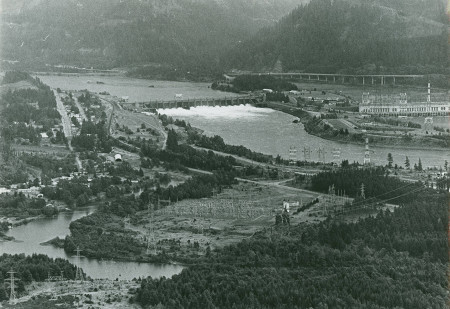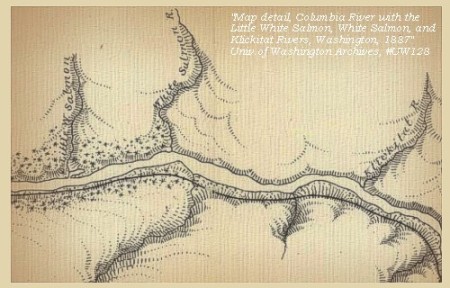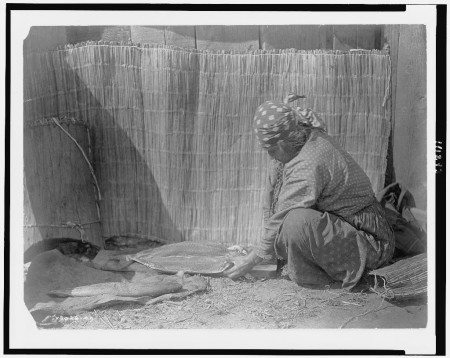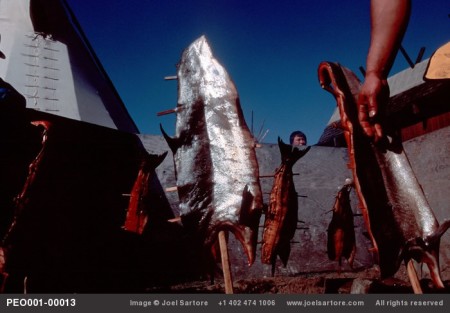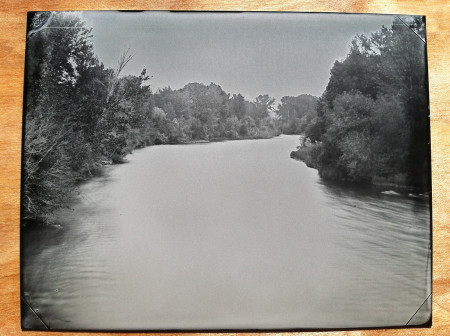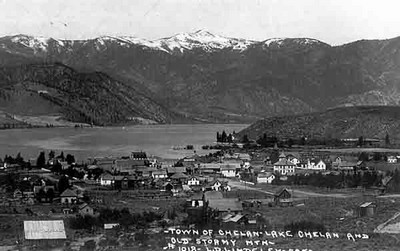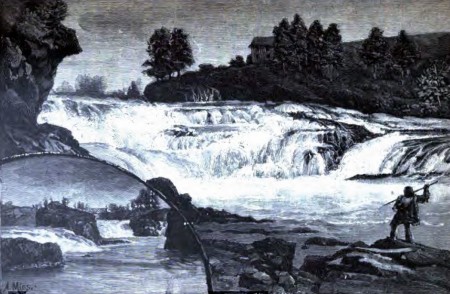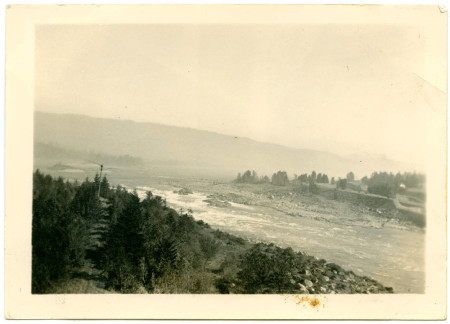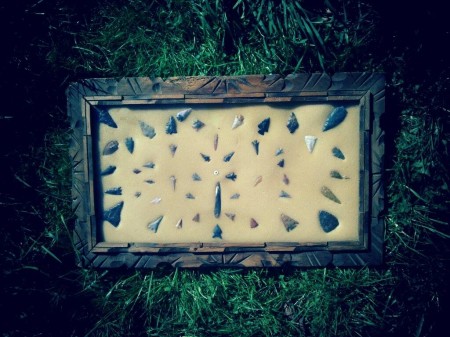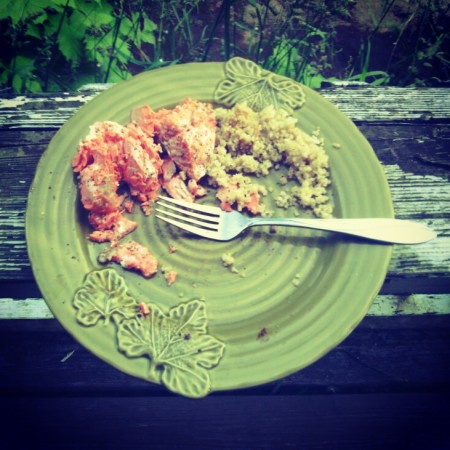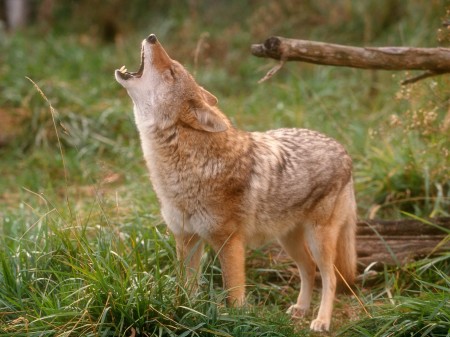This is a composite of many tales related by many tribes that once lived along the Columbia River and its tributaries. For the sake of this story, the many traditions have been weaved together. No one tribe told about all these deeds of Coyote.
The part about Lake Chelan and the waterfall was told by Billy Curlew, at that time he was the present titular chief of the Moses-Columbia band of Indians, to the Forest Supervisor at the agency at Nespelem, with lack Jack Weipe as interpreter.
After Old-One had made the earth and the ancient animal people, he sent Coyote among them, because they were very ignorant and were having a hard time. Coyote was told to kill the evil beings who preyed upon them and to teach them the best way of doing things.
First he broke down the dam which five Beaver women bad built in the lower Columbia.”It is not right,” he said to them, “for you to keep the salmon penned up here. The people farther up the river are hungry.”
Then he changed the Beaver women into sandpipers. “You shall forevermore be sandpipers,” he said. “You shall always run by the water’s edge. You shall never again have control over salmon.”
By this time so many salmon had come up from the mouth of Big River that the water was dark with them. Coyote walked along the bank of the river, and the salmon followed him in the water. At all the villages, the animal people were glad to see him and the fish he brought. Their hunger was over.
When he came to the Little White Salmon River, he stopped and taught the people how to make a fish trap. He twisted young twigs of hazel brush and hung the trap in the river. Then he showed the people how to dry fish and how to store it for winter use.When he came to the bigger White Salmon River, he showed the people how to spear salmon. He made a spear from the inside bark of a white fir tree and caught the salmon with the pointed end of the spear.
“This is how you should do it,” said Coyote.
Wherever he stopped, he showed the people how to cook fish. They had always eaten it raw. He showed them how to broil salmon by holding it over the fire on sticks. And he showed them how to cook it in a pothole. Along Big River, to this day, there is a round-bottomed hole in the rocks, a hole that people call Coyote’s Kettle. Coyote put salmon in that hole, poured a little water over it, dropped hot stones into the pothole, and covered everything with green grass to hold the steam. Thus the salmon was steamed until it was tender.”This is how you should do it,” Coyote told the people.
Then he and the people had a big feast – a feast of salmon cooked in the proper way, the way he explained to them. Coyote said to the animal people along Big River and along all the streams which flow into it, “Every spring the salmon will come up the river to lay their eggs. Every spring you must have a big feast like this to celebrate the coming of the salmon. Then you will thank the salmon spirits for guiding the fish up the streams to you, and your Salmon Chief will pray to those spirits to fill your fish traps. During the five days of the feast, you must not cut the salmon with a knife, and you must cook it only by roasting it over a fire. If you do as I tell you, you will always have plenty of salmon to catch and to dry for winter.”
Then Coyote traveled farther up the river, and the salmon followed him. Often he came to a smaller stream flowing into Big River. Because the people along the Yakima and Wenatchee rivers treated him kindly, he sent the fish up their rivers and promised them that every spring the salmon would return. Where he was treated very kindly, he made the river narrow in one spot. He would make the two banks of a river almost meet, so that there would be a good place for catching salmon.When he came to the animal people along the Chelan River, he said to them, “I will send many salmon up your river if you will give me a nice young girl for my wife.”
But the Chelan people refused. They thought it was not proper for a young girl to marry anyone as old as Coyote. So Coyote angrily blocked up the canyon of Chelan River with huge rocks and thus made a waterfall. The water dammed up behind the rocks and formed Lake Chelan. The salmon could never get past the waterfall. That is why there are no salmon in Lake Chelan to this day.
Coyote made a waterfall in the Okanogan River because the girls there refused to marry him. He made a waterfall in the Spokane River because the chief along the upper river would not let him marry any girl among his people. Coyote said to the chiefs along the Okanogan and the Spokane “I will make falls here. I will make falls so that the salmon cannot get past them, to your people farther up the river.”As Coyote traveled up the rivers, he gave names to the streams and the mountains. He killed monsters that were destroying the animal people. He killed the Ice People and defeated Blizzard, so that the winters would not be so cold.
He planted trees, so that when the new people, the Indians, should come, they could burn wood and keep themselves warm. He planted huckleberries in the mountains. “People must climb to get these berries,” he said. “It will not be good for them to get all food easily. They will become lazy.” He planted strawberries and service berry bushes. He planted camas, kouse, and other roots, so that there would be all kinds of food for the new people. After the new people, the Indians, came, he showed them how to make fire by twirling sticks between their hands. He made a long knife to cut with, and an ax to chop with. He peeled bark off a cedar tree and made a cedar-bark canoe. “This is how you should do it,” he said.
He taught them how to make bows and arrows from young arrowwood, and how to use the weapons. He made dip nets from maple and willow twigs, and showed the Indians how to catch salmon with them. He taught them how to make fishing platforms near the falls of Big River and how to spear salmon from these platforms. He made a basket trap also for catching fish. Coyote taught the Indians that salmon must always be kept clean. “if you do not keep them clean after you have caught them,” Coyote said, “they will be ashamed and not come up the river any more.
“And you must never cook any more than you can eat. If you cook three salmon when you are able to eat only half of one, the salmon will be ashamed and will refuse to enter your river.”
Many times he traveled up and down Big River and its branch rivers, teaching the people many useful things. Almost everything the Indians knew, Coyote taught them. He did many good things, but he did many wicked things also.
Indians say that when Coyote had done all the good things he could do, he was given a place in the sky. Other Indians say that he was punished for the bad things he had done.
He climbed to the sky on a rope. He climbed all one summer and all one winter. Then he fell down for a long, long time. When he struck the ground, he was mashed flat.
Lying there, he heard a voice say, “You shall always be a wanderer and shall forever howl and cry for your sins.”
That is why coyotes howl and cry at night. That is why they wander hungry and friendless over the earth.
*This story taken from the book Indian Legends of the Pacific Northwest, Ella E. Clark, University of California Press, 1953.

